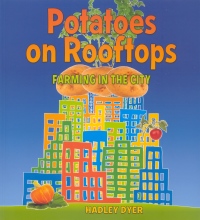| ________________
CM . . .
. Volume XIX Number 8. . . .October 26, 2012
excerpt:
Many children who live in cities have not had the opportunity to visit a vegetable farm or an orchard or to grow their own food. However, as the urban farming movement gains momentum, more and more kids might be able to have the experience of tasting fresh produce that they have grown themselves. Potatoes on Rooftops: Farming in the City not only explores small-scale urban farming and provides suggestions on how to begin, but it also touts the benefits of the movement, which include a positive impact on the environment, people’s health, and communities all around the globe. The book is divided into four main sections, each having seven or eight chapters. Dyer’s kid-friendly, conversational writing style will appeal to readers and engage them throughout. “Food for Thought” boxes provide additional trivia. Illustrations include diagrams and drawings, but mostly consist of vibrant colour photographs. A glossary, an index and a list of books and web sites for further study are also provided. The first section, entitled “Hungry Cities”, discusses the problems in getting food to people easily. Readers will learn terms such as “food miles” which refers to the distance that food has to travel to market, affecting both pollution and the loss of nutrients in the food (it is estimated that produce loses 30-50% of its nutritional value in five to ten days); “food deserts”, areas in which people live over 1.6 kilometers from a grocery store; and “food insecurity”, not having enough safe, nutritious food to fuel people’s normal activities. Startling statistics are presented, some of which are that one billion people worldwide survive on $1.25 or less per day, and that 30% of the people in sub-Saharan Africa are undernourished (this represents 239 million people). On the positive side, Dyer reports that unused spaces in many cities are being reclaimed for urban farming. In the second part, “Plant a Seed”, Dyer presents a brief history of gardens, such as the victory gardens which sprang up during the First and Second World Wars. She then describes a variety of garden types- vertical gardens (also known as “living walls”), vertical farms, pod-like greenhouses that resemble spaceships or giant insects, hydroponics, rooftop gardens, raised beds and micro-gardens- and provides tips for starting a garden, considering space, cost, taste, time, and the little critters, both wanted and unwanted, that might visit it. Micro-gardens are growing in popularity due to the fact that they can flourish in very tiny (and unexpected) spaces, such as buckets, plastic bins, bottles, window boxes, or even a colander or a kiddie pool. Community gardens, too, are a way of gardening and sharing produce with others. Finally, in this section, Dyer explains the difference between heirloom and hybrid plant varieties and extols the benefits of gardening- getting exercise, sunshine, fresh air, and better nutrition from home-grown produce. Gardening is even considered a mood and energy booster. Plants are able to cool cities in many ways: trees provide shade; green roofs lower temperatures from transpiration; and carbon dioxide is removed from the air. In the third section, entitled “Green Your City”, readers will also learn about perennials, preserving the harvest via canning, dehydrating or fermenting crops, the benefits of aquaponics (aquaculture combined with hydroponics), and raising small animals for food. Other topics in this section include composting, water harvesting and how to turn animal manure into energy. Finally, the fourth part of the book is based on the adage “think globally, act locally”, and provides several examples of community efforts in schools and organizations in various areas of the world. Some of these include a school in Detroit where students learn how to grow their own food and raise bees, chickens and rabbits, the Wood Street Urban Farm in Chicago which offers a training program for poor and homeless people, and a high school in Toronto which operates Canada’s first school-based market garden. At this school, there are more than 26 raised beds, as well as compost bins, rain barrels and a greenhouse. Some of the harvested crops are cooked in the culinary arts class and served in the cafeteria, while the remainder is sold at the weekly market garden. Loaded with information and helpful hints, Potatoes on Rooftops just might inspire some individuals to join the urban farming movement and start small gardens at home or even at school. Highly Recommended. Gail Hamilton is a former teacher-librarian in Winnipeg, MB.
To comment
on this title or this review, send mail to cm@umanitoba.ca.
Copyright © the Manitoba Library Association. Reproduction for personal
use is permitted only if this copyright notice is maintained. Any
other reproduction is prohibited without permission.
NEXT REVIEW |
TABLE OF CONTENTS FOR THIS ISSUE
- October 26, 2012.
AUTHORS |
TITLES |
MEDIA REVIEWS |
PROFILES |
BACK ISSUES |
SEARCH |
CMARCHIVE |
HOME |
